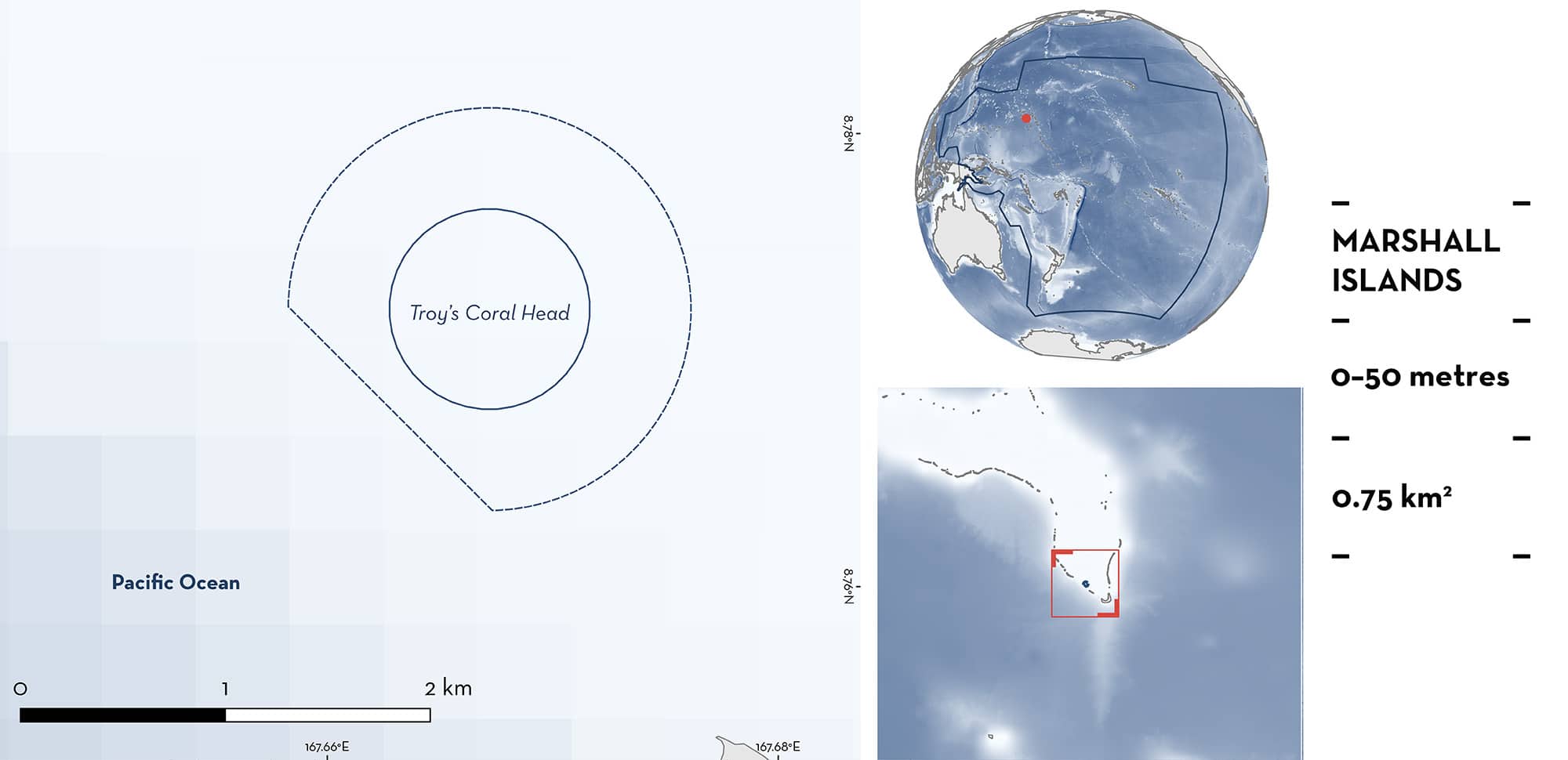ISRA FACTSHEETS
ISRA FACTSHEETS
NEW ZEALAND & PACIFIC ISLANDS REGION
Troy’s Coral Head
Summary
Troy’s Coral Head is located in the Republic of the Marshall Islands in the central Pacific Ocean. It is situated on the southwest side of the lagoon in Kwajalein Atoll. This area encompasses a large coral head. The top of the coral head is ~5 m and the sandy seafloor reaches a depth of ~50 m. Within this area there are: threatened species and undefined aggregations (Grey Reef Shark Carcharhinus amblyrhynchos).
Download factsheet
Troy’s Coral Head
DESCRIPTION OF HABITAT
Troy’s Coral Head is located in the Republic of the Marshall Islands in the central Pacific Ocean. It is situated on the southwest side of the lagoon in Kwajalein Atoll. This atoll is one of the largest in the Pacific Ocean with a lagoon that has an area of 2,174 km2. The lagoon has a maximum depth of ~100 m, and an average depth between 25–50 m with sporadic coral heads. The area is situated around a large coral head on the southwest side of the lagoon. The top of the coral head is ~5 m and the sandy seafloor reaches a depth of ~50 m (Kwajalein Dive Center 2024). Often large bait balls of Bigeye Scad Selar crumenophthalmus, Red Snapper Lutjanus campechanus, amberjacks Seriola spp., and occasionally tuna (family Scombridae) are observed circling the coral head (E Gill pers. obs. 2024).
This Important Shark and Ray Area is benthopelagic and is delineated from inshore and surface waters (0 m) to 50 m based on the bathymetry of the area and occurrence of the Qualifying Species.
CRITERION A
VULNERABILITY
One Qualifying Species considered threatened with extinction according to the IUCN Red List of Threatened Species regularly occurs in the area. This is the Endangered Grey Reef Shark (Simpfendorfer et al. 2020).
CRITERION C
SUB-CRITERION C5 – UNDEFINED AGGREGATIONS
Troy’s Coral Head is an important area for undefined aggregations of one shark species.
This area is a well-known dive site on the Kwajalein Atoll and is recognised for the regular and predictable interactions with large numbers of sharks that are chasing school of fishes (Kwajalein Dive Center 2024; UW360 2016). Since at least 2015, recreational divers that visit this site regularly (at least twice a month) year-around have observed aggregations of Grey Reef Sharks on all dives. Sharks are usually in groups of 20–30 animals on average, with a minimum of 7–10 individuals, but aggregations of up to 50 individuals have been observed. Grey Reef Sharks are usually recorded chasing or feeding on schools of fishes (Bigeye Scad, amberjacks, Red Snapper, and sometimes tuna with occasional feeding frenzy behaviour (E Gill & J Spaeth pers. obs. 2024). Sharks were visually estimated to measure ~100 cm total length (TL) (E Gill pers. obs. 2024). Considering the size-at-maturity (120–142 cm TL for females, 130–145 cm TL for males), and the size-at-birth (45–64 cm TL) for this species, most individuals were juveniles. This area might function as a feeding area; however further information is needed to confirm whether Grey Reef Sharks are only opportunistically feeding here because of high prey abundance.
Download factsheet
SUBMIT A REQUEST
ISRA SPATIAL LAYER REQUEST
To make a request to download the ISRA Layer in either a GIS compatible Shapefile (.shp) or Google Earth compatible Keyhole Markup Language Zipped file (.kmz) please complete the following form. We will review your request and send the download details to you. We will endeavor to send you the requested files as soon as we can. However, please note that this is not an automated process, and before requests are responded to, they undergo internal review and authorization. As such, requests normally take 5–10 working days to process.
Should you have questions about the data or process, please do not hesitate to contact us.


